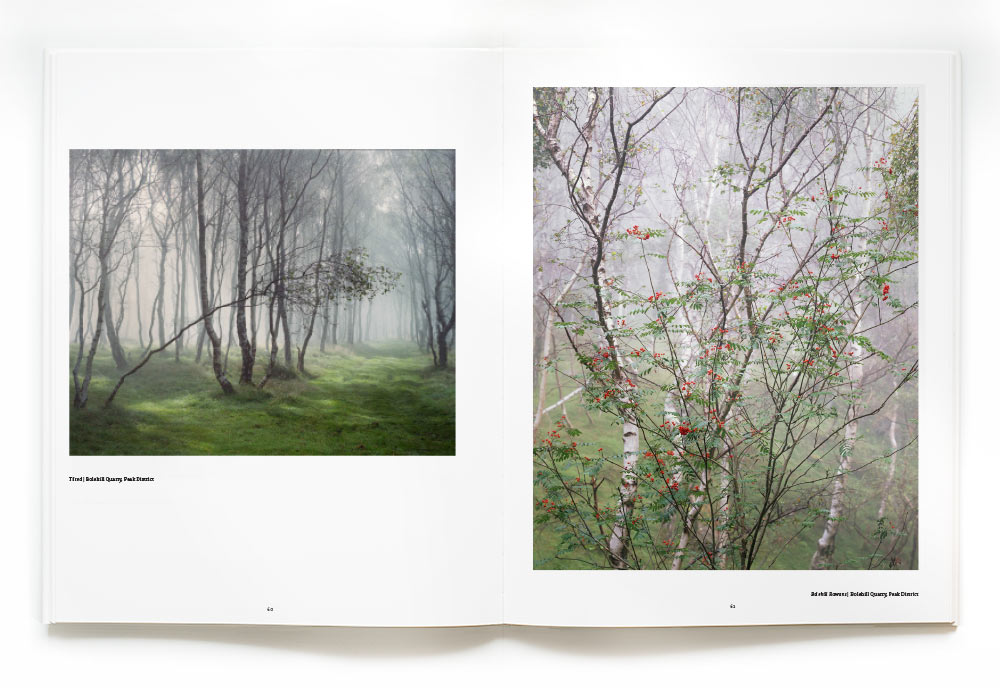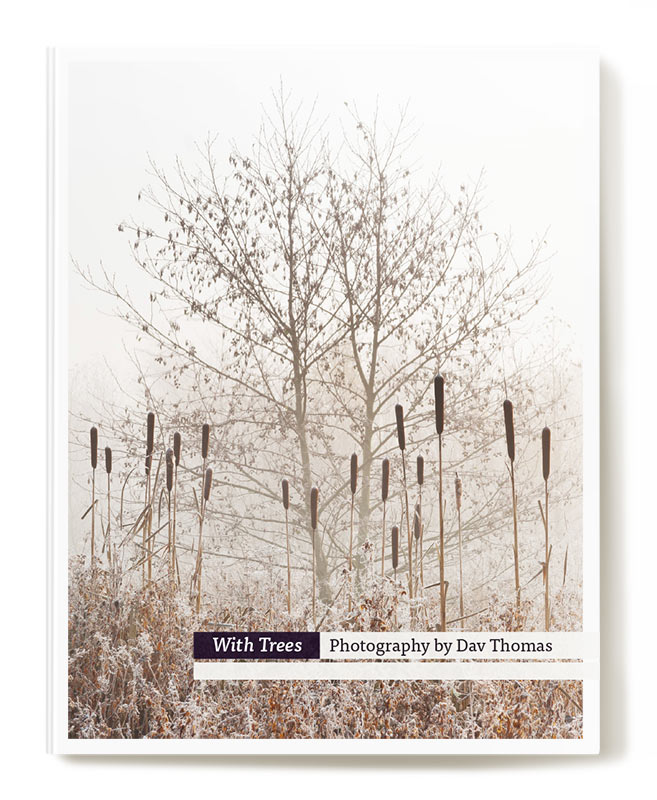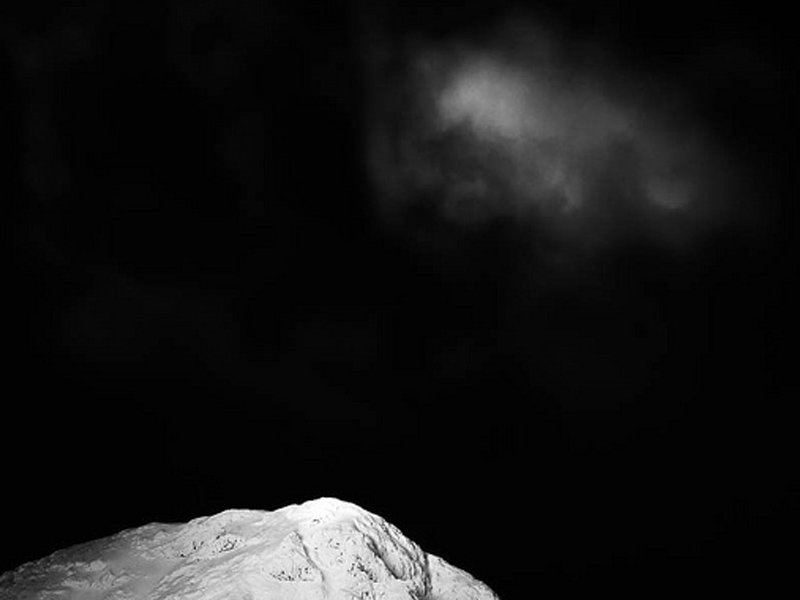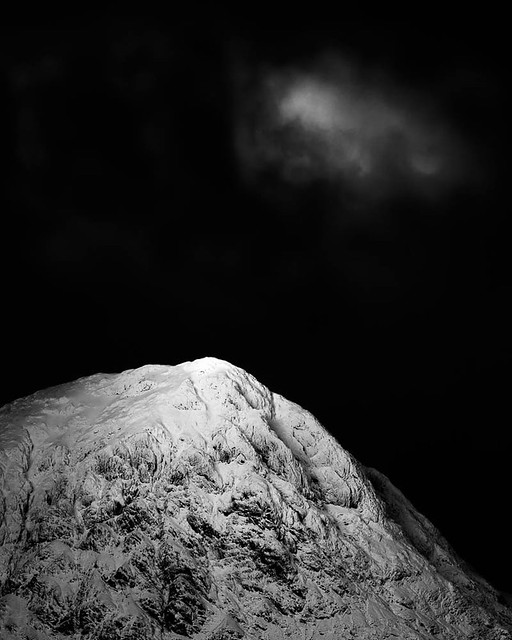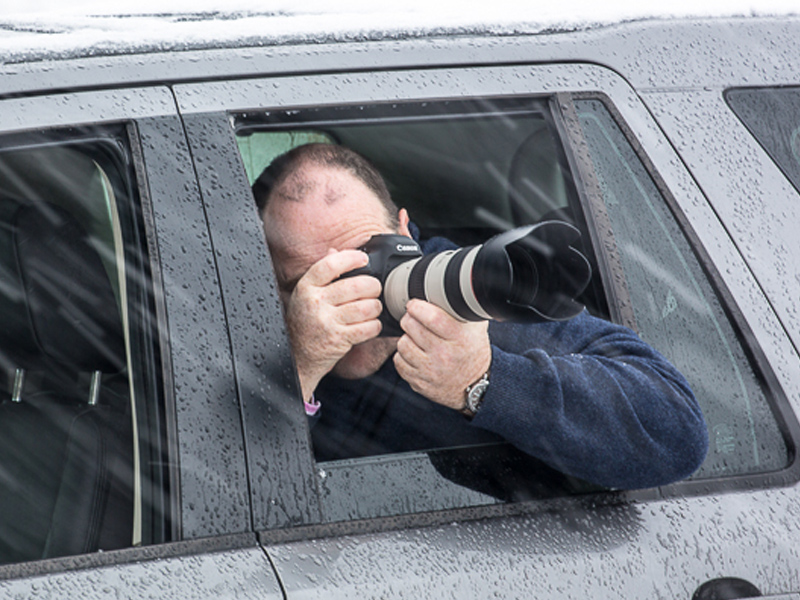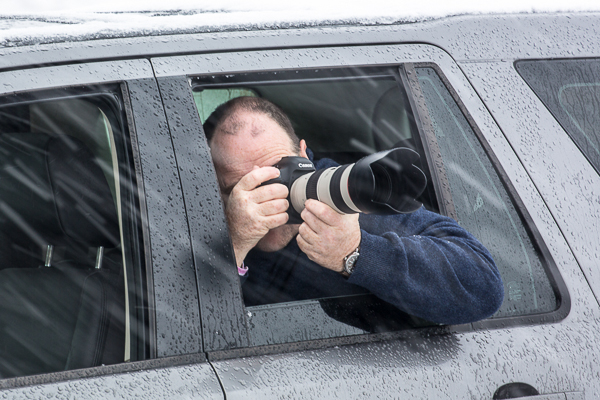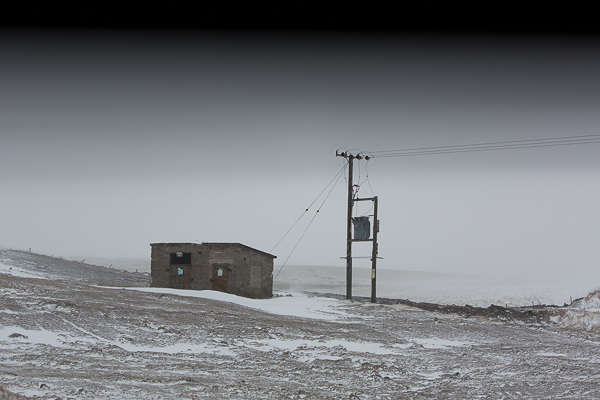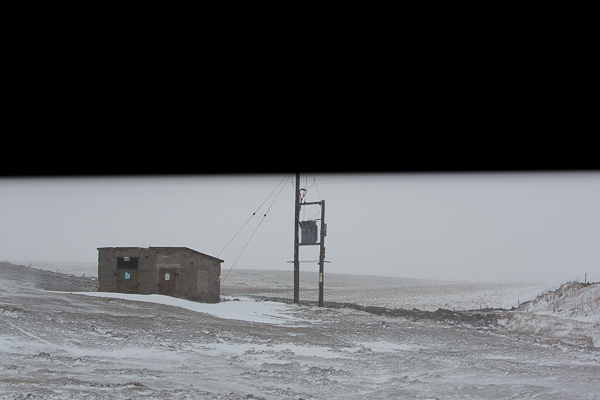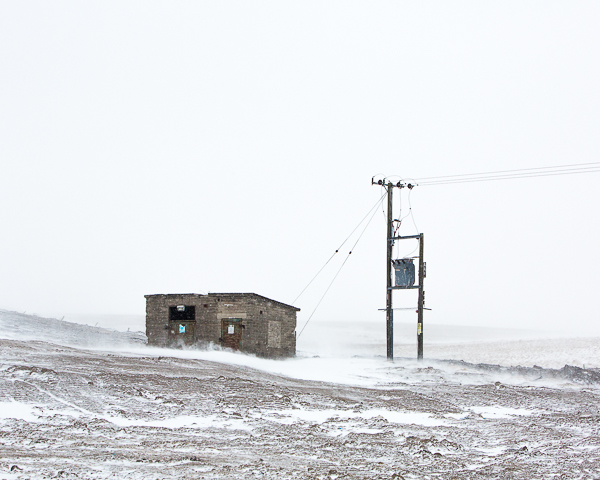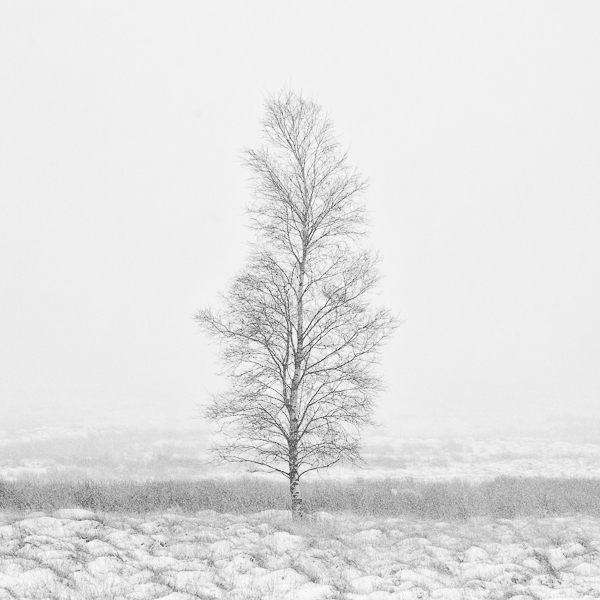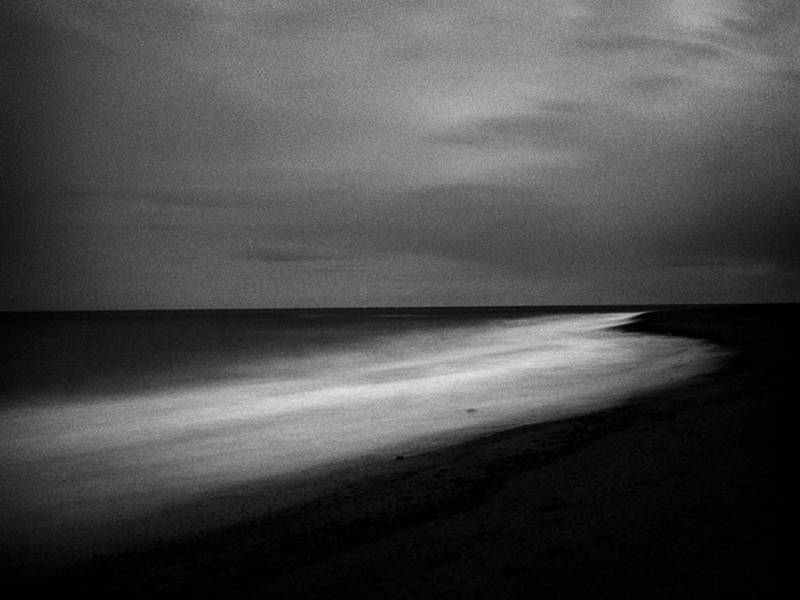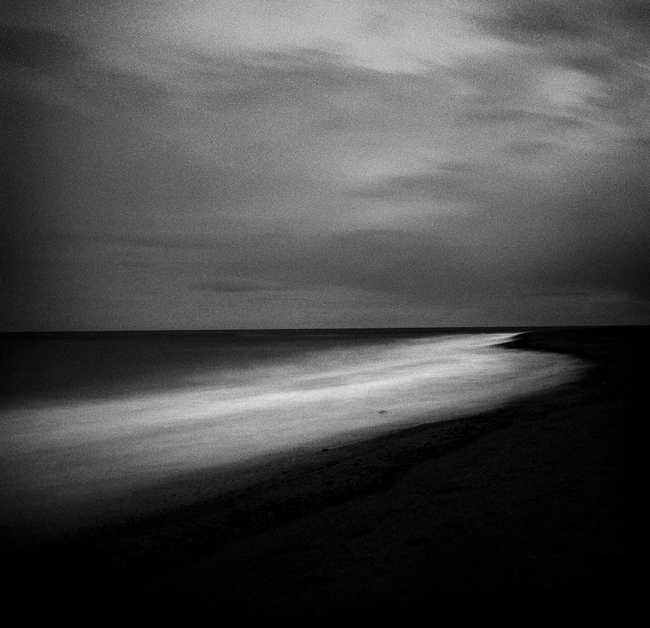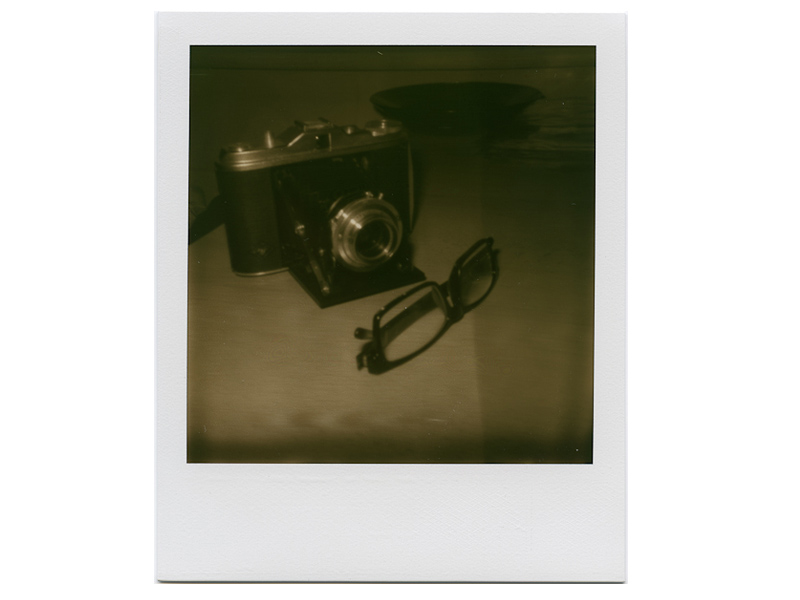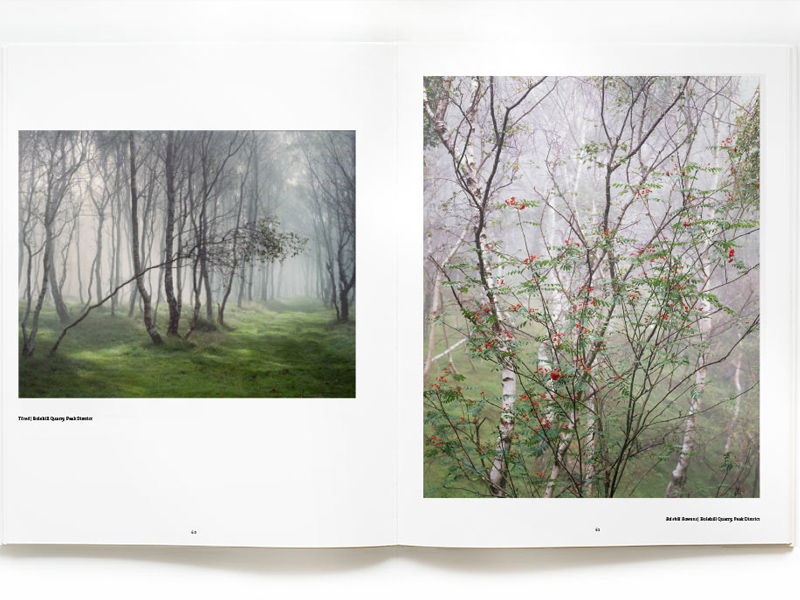
In 1961 a very young Bob Dylan recorded “Blowin in the Wind” and within months his life had changed forever. After seeing “With Trees” I have a feeling life won’t ever be quite the same for Dav, either.
So here we are in the lull before the storm. I think it’s true to say that, outside of UK landscape photography circles, Dav is largely unknown. But amongst us he already has a reputation for quietly doing his own thing with no other purpose than to make beautiful images. If Dav tweets a link to a new image on his website, Twitter goes quiet for a while as we all click to see what he has achieved this time. Then the retweets and plaudits begin, such is his reputation.
So when it was rumoured that Dav would like to “do a book”, many urged him forwards and since then the landscape photography community in the UK has held its communial breath and waited. The waiting is almost over.
Davs reputation is largly built around his images of trees and woodlands and so it was natural that they should be the basis for this book. I haven’t seen a physical copy of the book itself for this review as it is currently being printed in Europe, but knowing Dav and his attention to detail it will be beautifully finished and presented.
So what can we expect as regards the presentation of the book and its technical specification? The book is quite large, bigger than many photography books at 270 x 345mm with 112 pages. The hardcover is to be printed directly, so no dust jacket, and the cover is matt laminated. There will be 88 photo plates.
Dav and David are pushing for real quality with this book by opting for 170 gsm paper for the inner pages. This quality is further emphasised by the fact that they have opted to go for the more expensive but infinitely higher quality stochastic litho printing which is very close in quality to fine ink jet printing as opposed to using dot pattern printing employed in more cheaply produced photography books.
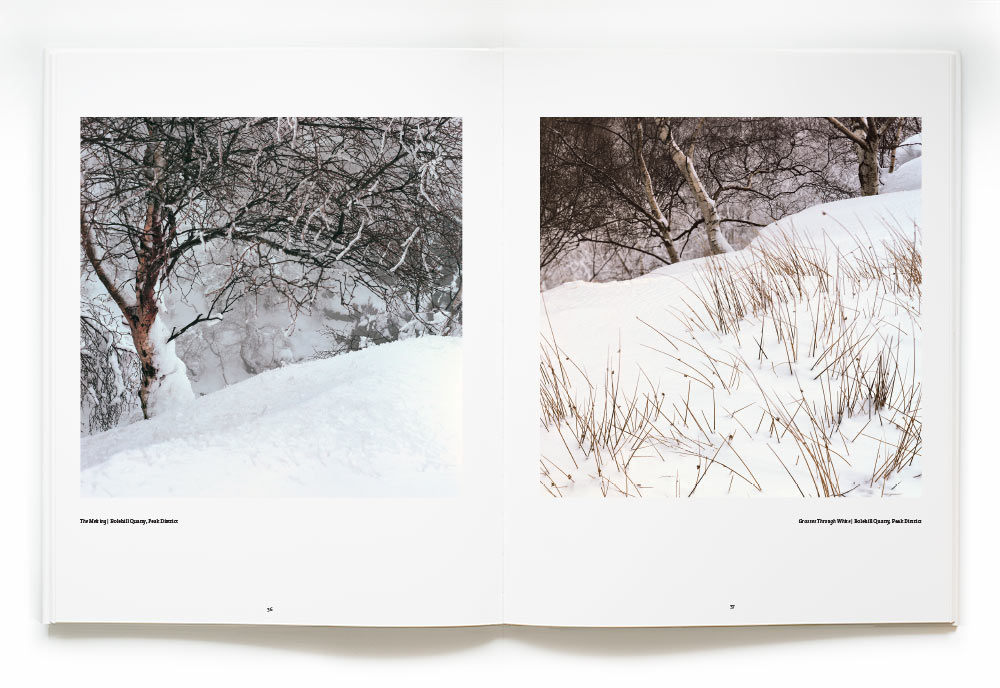
There are to be a very limited run of 30 luxury limited edition books, signed and numbered, which come with three of Davs signed prints (you can’t choose which, but if you know his work, this shouldn’t be an issue). These prints are limited to the book making this a very good value purchase for those fortunate enough to secure one. The prints will be made on 310 gsm Photorag paper at 195 x 245mm, each individually signed and numbered. This edition also comes in a foil blocked slip case at £125 plus postage.
There is also a special edition of the book limited to just 50 copies which comes with one of Davs signed prints (print specification as above) which will not be available elsewhere. (Again you cannot choose which print) These books will be signed and numbered by Dav and also come in a foil blocked slip case. The price for this edition is £75 plus postage.
The standard edition of the book, pre-ordered, will also be signed. These are priced at £40 plus postage.
The book is now available to pre-order now (from 28th April 2013) from the website http://www.withtrees.co.uk and for those who do pre-order and pay in advance for their copy are to be rewarded with a gift of an additional signed print. These won’t be available once the book goes on general release, so a very good reason to pre-order your copy.
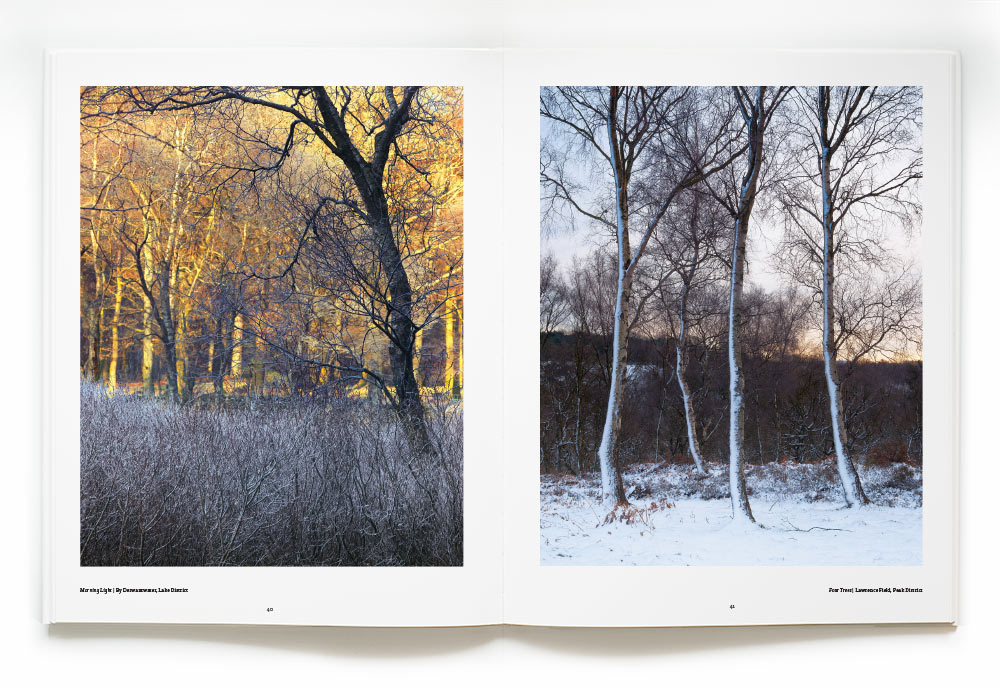
The book is being published by David Breen at the newly formed Triplekite Publishing and I interviewed David recently about the project. (This interview took place about a week before the book went on pre-release).
Is your background in photography?
I am not that sure I would describe what photography means to me as a “background”much as a passion. I have had numerous cameras over the years, but for a long time I “took” some photos as opposed to “making” an image. Quite a few years ago I stumbled into landscapes and it felt natural and to be something I could become knowledgeable about.
For me, my photography passion is not just about making an image myself, I am genuinely fascinated and enthralled by the genre in its entirety. I probably started to become somewhat proficient myself about the same time as my 3 children arrived. So as I should have been practicing more and developing, I found an equal lack of time.
So I am possibly more versed in the output of other people’s photography than my own. I have also always had a borderline obsession with books and learning, which is my career, so naturally the genre of the Photo Book became a real interest and active collection.
How did the project between you and Dav come about?
I have had a few ideas for books over the last few years, associated with photography mainly and the organic aspects of corporate structure and politics as another, not surprisingly I think one of those will be a little more interesting to produce than the other. Parking the delights of comparing plants to large corporates to one side, I started to look for a photographic related book project. This is where twitter, some fortuitous coincidence and going with your instincts combined. I knew of Dav and his work through twitter and I decided for many reasons to try out working with film. I got amazing help over many days of many people, but most notably Tim Parkin and Dav. Between them 140 characters and the odd email, they taught me zone metering and off I headed to Padley Gorge. As I parked up in Surprise View car park I saw a fella wandering around the woods with a square of cardboard in front of his face, coincidence meant I met Dav Thomas, who was as helpful in real life as online. A few months later a bunch of people were asking, encouraging, cajoling Dav to publish his own book via twitter and it seemed a natural question to ask if he would like some help to do so.
Why did you think it was worth backing a book by Dav?
Oh, that’s a tough question, there are so many reasons and so few of them all that logical. I would love to say its because I have years of experience on photo book publication and can spot real, undiscovered talent, but that would be a lie. And to say I think this will be a huge commercial success would be a lie too. Probably the closest I can get to explaining it is to say, I believe his work has a unique feel to it which can be appreciated by both photographer and non, in equal measure. And that doing this, gives me the opportunity to fulfill a personal goal, business goal and to help someone else, helped me, in the process. Which is not to say I don’t think it will be a commercial success, or that it won’t lead to other things.
What were your first thoughts about the book when you saw Dav’s early proofs?
Shock, amazement, satisfaction and relief. Shock that he had achieved so much in such a short period of time, I was expecting a book layout with maybe ten percent of the images in it for illustrative purposes, what he sent looked almost finished. Amazement at just how good it was, and that every page turn seemed to reveal another gem. As well as the images which he hadn’t shown publically, those a little different. Satisfaction that my gut instinct was looking to be proved right, and relief that Dav and I wouldn’t be working the car boot sales of Northern England for the next couple of years.
Do you have a background in publishing?
This will be the first book my company has published, which is a business goal of mine achieved. When we get to send that first edition off to the national archive of the British Library, which is a legal requirement, it will be a very special moment to me personally and I expect Dav also. But to say I am completely new to publishing isn’t exactly the full story either. I have worked for nearly 20 years in the field of professional learning and development and in that time have supervised and been responsible for the publication of many things. So the process of it isn’t new. My company today also has a fledgling business channel in greetings cards and calendars from other photographers known to me.
What difficulties have you encountered in the process, and how have you overcome them?
We have been lucky so far in this respect as Dav is also a graphic designer, so the book layout etc. is down to him. With that experience comes many print contacts and support. I think we are also in that fortunate position of it being our first, so we don’t know what mistakes we are making, and are therefore not precious about changing our decisions. The quality of the finished book is always the deciding factor. At the end of the day, Dav has put his faith and trust in Triplekite to help him to produce as good a book as we can of his work. We believe we are working with a photographer of high enough quality and potential that we can truly make something great. The rest as I so often say “is just noise”.
We are planning to have the book in the UK, in our possession during July of this year, and launch at the Masters of Vision Exhibition where Dav is exhibiting.
Will you be selling through book shops, through online retailers or just through Davs website?
We are still very much in the planning stages where this is concerned, initial pre orders with the “thank you” print, will be sold direct. We are still in ongoing planning & in some cases discussions with numerous retailers, both independent and larger. We do however only have 600 copies in the first edition, so its very much dependent on how the pre orders and initial sales go.
How are pre-sales going at this early stage, is much interest being shown in the book?
So far we have only really soft launched it to friends via twitter, Facebook and Davs website. Support has been incredible and we are truly appreciative of all the support. To show how much that support means, we changed our pricing strategy by asking anyone who cared to contribute to tell us how much the book should be. Its fair to say that we dropped the price of one edition, kept the price of another the same, and chose to ignore the opportunity to raise one price based on the feedback given.
If the project is a success, do you think you would like to be involved in another photography book?
I think so yes, ISBN numbers are bought in blocks of ten so I have 9 remaining, 8 if I include the “Organic Organisation book. But all joking aside we have spoken about other titles with some people. The attention, resource, energy and focus right now, is about making this book as good as it possibly can be.
If so, any hints as to photographers you might like to feature, or is that all under wraps at the moment?
I think it would be unfair and commercially unwise to talk about any particular photographer. There are of course names who are producing great work right now but are yet to be published, these artists spring to mind when asked, but who knows. It may not even be a monographic work. The other answer is of course that we are open to ideas and approaches, talking about possibilities costs nothing, but rarely is anything made that hasn’t started with a conversation. There will be many, many photographers out there with great skill who we have no idea even exist right now.
Have you considered publishing a book of your own images?
Of course I have… I have a project called “18 months” which is a journal of hotel room images I have stayed in during my recent business life… and if I ever find a desire to own 600 copies of my own book I will definitely be publishing it. My commercial side suggests to me I will be better off publishing other work, or a “set of 6 postcards” of my own. 😉
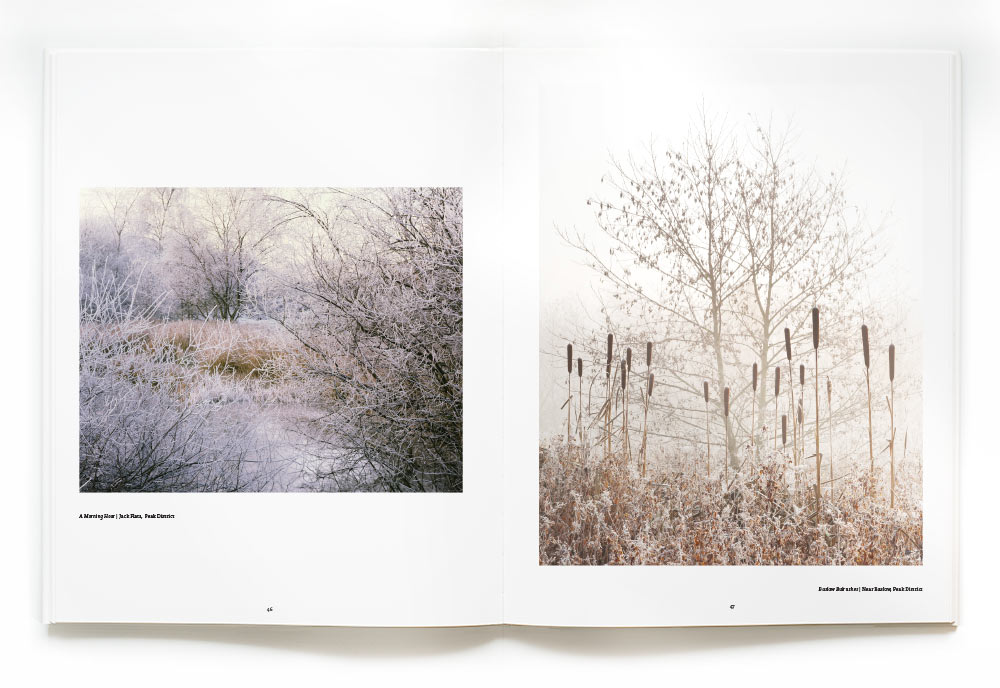
So what are my impressions of the book?
The first thing I saw was the cover image of Bullrushes in the Frost, which is a particular favourite of mine. In fact, I have a print of it on the wall of my studio. It. Is a fitting image to set he tone for the rest of he book.
Inside we find a foreword from David Ward, which again says much about the book and even more about Dav and his work. David would not put his name to any book that did not show the very highest of standards in photography.
Turning a few pages soon confirms that Dav spends most of his time photographing in mist, frost and very subtle light. If you are a lover of intense sunrises and post apocalyptic colours then this is not the book for you.
Most of the images are made in the Peak District close to Davs Sheffield home, although interspersed among them are images from Scotland, the Lakes and elsewhere. Using, mainly, a 5 x 4″ large format film camera, Davs images reveal intense detail and subtle colour and tonal detail. He works with a number of film types and these seem to be chosen to work well with Davs chosen subtle light and colour palette.
It is evident from close inspection that Dav takes great care when scanning his negatives or transparencies to maintain the subtleties the film has captured. He then maintains this subtlety by going gently with the sliders and controls in the software. Just because a slider goes to ten, he certainly doesn’t feel the need to push it to ten. There is a lesson there.
For many of us, to wander into a woodland with our camera is to come out in a cold sweat. For many it is not long before we wander back out again in search of a nice easy beach, some lovely boulders or a comfy lake. The confusion, tangle and chaos of the woods can be intimidating. Where are the flowing lines? The foreground interest? The fore, middle and background all neatly delineated? Where is the sky? The horizon? Minimalism? No chance. Simplicity? In your dreams! And yet, here is Dav Thomas making it look effortless. The chaos is tamed. The tangle, untangled. The confusion, simplified. It can’t be as simple as he makes it look.
A close examination of the images reveals that he doesn’t just point his lens at just any old tree. He obviously takes enormous care in searching out his subject and then dignifying it by carefully placing all the elements so carefully in the frame. And all this in fast changing light with a large manual camera with no instant feedback screen and histogram. This is evidence of a master at work.
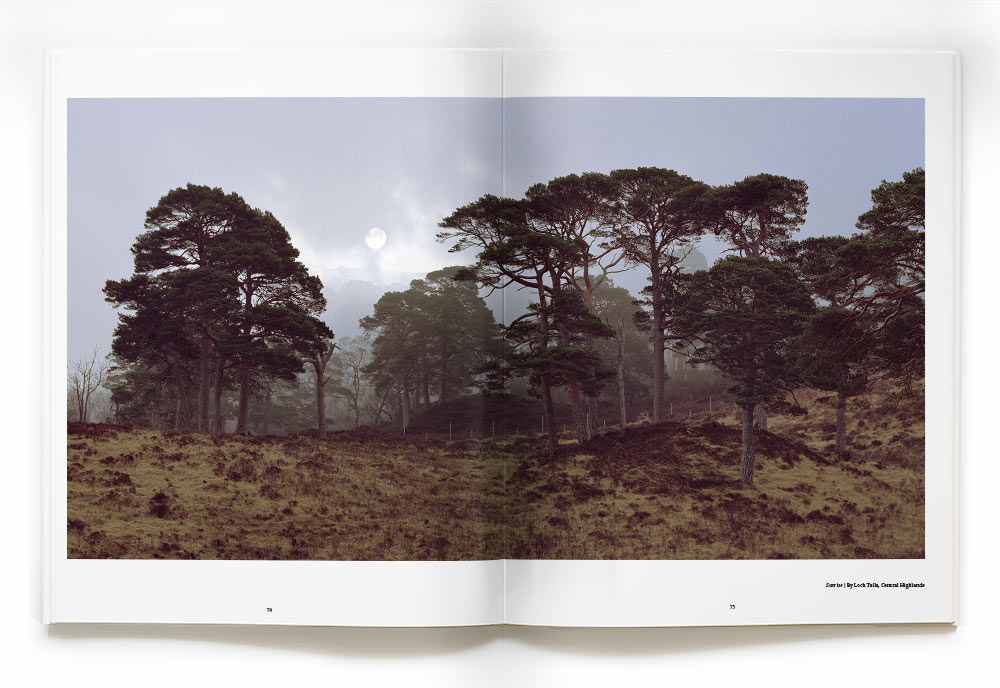
While many images in the book are shot and revel in the colours of autumn, Dav doesn’t rely solely on this season to make his images. We find many are also shot in spring and through winter. If anything, I get the feeling Davs camera lies undisturbed for the summer. I failed to find any images which were clearly shot in the warmer months.
If anything comes close to competing with the trees which are the star of he show, it is the weather. Frost, mist and various types of subtle light show off the trees to best effect. I also suspect Dav has an affinity or grasses and bracken too as they often feature as strong elements in he images.
I was pleased to be able to interview Dav recently about the book. Here is what he had to say.
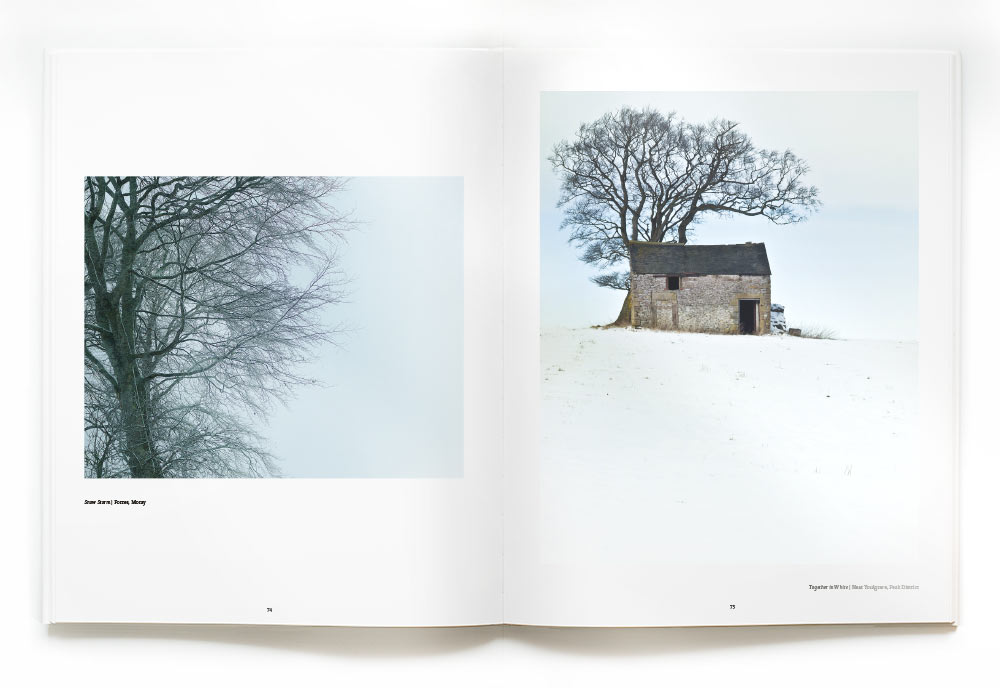
Dav, can you tell me a bit about your photographic background?
I’ve more or less always had photography in my life, it was a passion ignited by my cousin who taught me how to print my then rubbish black and white photos in his darkroom when I was about 10, he also gave me his hand-me-downs, allowing me to set up my own darkroom. I studied photography a bit at art college, but then became a graphic designer by mistake! I carried on with photography using medium format cameras, mainly alongside my graphic design business, offering product photography as part of the service. I became interested in landscape photography about 6 years ago – it was part of a plan I had to get fit (which didn’t work!).
For those interested, what sort of kit do you use for the images in the book?
I almost exclusively shoot film for my landscape work (are trees landscapes? Maybe treescapes might be a more appropriate term!). Soon after taking up landscape photography I followed the obvious route and ‘went digital’ and sold all my medium format kit, processing equipment and drum scanner. It didn’t take me long to realise I’d made a big mistake though; digital just wasn’t cutting it for me. So I returned to film, only bigger – I took up large format.
The vast majority of images in the book are shot on 4×5 film, either with a Linhof Technikardan s45 or a Chamonix 045. Most images are made with a Nikkor 300mm lens, which is equivalent to about 80mm in 35mm terms. There are a few images made with a digital camera – my Sony a900, a few medium formats (a Hasselblad 500c/m) and a couple of 35mm film camera images. There’s even an image in there taken with my iPhone!
Why do you prefer to make most of your images on film?
There’s a number of reasons; firstly, and I suppose most obviously, is the quality you get from film, particularly large and medium format. The quality isn’t confined to size and detail; for me the real benefit is the tonality of film – it brings a scene to life and by utilising different film stocks I am able to render scenes differently. Increasingly, I’m using negative film, which gives me a huge dynamic range and its tones are soft and understated, which I prefer in my images.
Secondly, the large format camera pushes me to work in a certain way – it’s a much more pondered way of working than with a 35mm film or digital camera. I do the majority of my visualising before the camera even comes out the bag – I work the scene slowly, it’s almost like stalking an animal (probably, I’ve never actually stalked an animal!); hunting down the best angle, working out how the image can be distilled to its important compositional parts.
The way the image is viewed on the ground glass is also important to me. Being under the dark cloth focuses the mind, cutting out any external influences, allowing me to totally concentrate on the composition of the image.
Why trees?
Good question! I’ve always had a love of trees I think, I have great memories of playing for hours in the lightly wooded area near my house as a child. The wonderful feeling of having an area of woodland to myself remains today, without sounding to New Age; it’s almost like being a fleeting guest amongst their midst. I started off with landscape photography much in the same way as most other people; views, the seaside, foreground interest and wide angle lenses. I soon realised this wasn’t reflecting ‘me’ and my connection with the landscape, I started exploring more local ‘wowless’ locations and inevitably this lead me back to woodland. I’m fascinated by the textures of not only the trees themselves, but also the grasses and mosses that go along with them, and of course the changing atmosphere as the seasons change.
I must say I gain great pleasure in finding a location that no one has ever bothered even looking at before and finding beauty within it. There’s much more pleasure for me in making an image in such a location than I’d get from any honey spot location in the world.
Many photographers avoid photographing in woodland. They struggle with the confusion and chaos. How have you overcome this? How do you find your compositions in such a chaotic place?
I really enjoy the challenge of finding images in these chaotic environments. I wouldn’t say I have a set formula for making my images in woodland – at least, not one that I consciously think about. I tend to approach my photos as a graphic designer – I look for an interesting shape, colour or texture that I can use to make a composition, it’s then a matter of working out if I can find a composition with those elements, usually this entails removing as many elements as possible to emphasis the feature that originally drew me in. I’ll do all this before I even consider getting the camera out; using a plastic viewing card to find the composition. One technique I use is to utilise swing on the large format camera to emphasise the relationship between two or more trees, that way I can throw areas of the photo out of focus, drawing the eye into the photo establishing the visual link that I want to portray.
You have a reputation amongst landscapers for being down to earth and not ‘arty’ about your images – what is your philosophy about making pictures (if that’s not too arty a question!)
I can’t be doing with people forcing the ‘I’m an artist’ thing down people’s throats. There’s no great concept behind my photographs – that’s not to say I’m flippantly taking photos when I go out – I feel a great connection and love for the landscape that I’m photographing and I hope that love comes out in my images. I simply photograph the things that fascinate me, treating the components of the landscape as elements to make graphic compositions with. It’s not for me to tell you my images are art – if the viewer considers them to be art, then all well and good, but I think it’s up to my audience to decide, not me.
How did you feel about working with David at Triplekite on the book with this being your first book, and his?
I must say, until David approached me about it, I’d never really considered producing a book – I suffer somewhat from self doubt when it comes to my photography, and without the help and encouragement from David (and a number of my Twitter contacts), my photos wouldn’t have made it much further than my website. I’m sure David’s job has been made easier by the fact that I’m able to design and produce the artwork for the book myself, meaning we haven’t had to deal with any third parties.
How has the collaboration between you worked?
It’s been rather a laid back relationship, but it’s been great to have someone who’s a natural salesman pushing me to get the book moving (I’m not the most organised person!). David’s input about editions, pricing, marketing and the like have been invaluable. David has been busy sorting out the technicalities – ISBN numbers, costings etc. leaving me to concentrate on photo selection, design of the book and the book’s website. I only wish he could write the copy as well – as it’s not a job I enjoy!
If this book is a success, do you think you could see yourself working together on other photographer’s books with you doing the design and David handling the publishing side of the business?
It would be great to work on the design of other photographer’s books with David and we have discussed the idea of working together further – so hopefully our working relationship will continue.
How did you choose which images to go in the book?
The difficult part of the selection process was trying to get a flow through the book – I wanted images that worked together and not to have too much of a jar when you turn the pages. The book is roughly organised by seasons, but as I have very few images from the summer months, it is definitely winter heavy! There are a few images that I have not been able to include, just because they don’t fit in with the mood of the book. The layout of the book allows for different sized images, which means I can use some images shot on smaller formats, whilst maintaining the quality of the images; they just appear smaller. The amount of pages in the book was only governed by how many images I had to include so I basically just chose the images that I feel most happy with.
I’m very tempted to ask if you are good at everything you do? I know you make amazing Indian food, bake superb bread, you are a talented graphic designer and hand make furniture with your own VW camper interiors business. All this, and you are a master with a camera? Please tell me there is something you can’t do?
Haha, well Caryl, my girlfriend, say’s she’ll make you a list of things I’m no good at if you like! I’ve never liked the idea of being just one thing… a designer, a furniture maker or a photographer. I’m passionate about design and love to design furniture, brochures, websites and photos! I consider photography to be an extension of the design process, my photos are designed just as much as a brochure layout or a website design. The downside of this is that I’ve constantly got some creative dilemma going on in my brain, resulting in my inability to switch off and go to sleep – one thing I definitely can’t do well is go to bed and get to sleep at a reasonable time! As you mention, I also love to cook – I’m not one to do things by halves, so if I’m going to take something on, I tend to get obsessed with it; I’ve spent hours on curry forums trying to work out how to master the techniques involved, but like my photography; however hard I try, I never think I’m quite good enough at it!
Do you have the images to make another book if this book does well?
I certainly don’t have another books worth of tree photos (I’m not sure the world could take another book of tree photos!). So this will be the last proper book from me for a few years I think. I do have some ideas for a very different publication though in the next year or so.
I understand the release of the book is to be timed to coincide with the Masters of Vision exhibition. Will some of the images in the book be exhibited?
Yes, I all the images in the Masters of Vision exhibition will be images from the book, unless I manage to make 12 new masterpieces before then, which I think is unlikely!
What’s next for you, Dav? What are your photographic plans?
I have a rough plan for a project, which has a working title of ‘without trees’! I don’t want to get comfortable with my photography and just replicate what I’ve produced before, although I won’t go out of my way to work in new ways and produce ‘art’ for art’s sake. The project I want to work on will be focusing on the Peak Districts moorland which I’d like to cumulate into a hand made, very limited edition, hand printed large format book. Back in my hippy days (!) I used to make my own paper and bind my own books – whilst I won’t be going as far as producing my own paper, it would be great to do my own binding. I see these as being very different images to my usual style, I need to get on and see where it takes me…
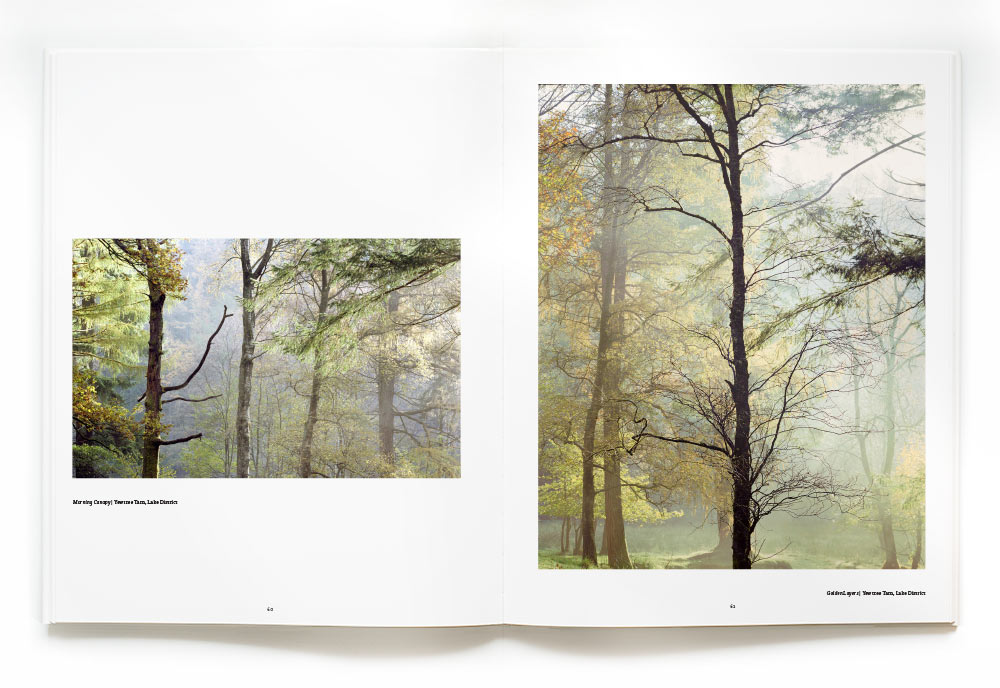
Many of the images are well known to those of us who love Davs work. Indeed, it would be like going to a Dylan concert and him not singing “Blowin in the Wind” if they weren’t there. But in amongst them are many new images too, including some wider landscapes for which Dav is less well known. Some photography books are comprised of many strong images but are filled out and somewhat diluted by a proportion of weaker ones. That is not the case with this book. In fact, there is only one image I really don’t “get” and that is more likely to be me rather than the image! In fact, in this book you will see many images I truly feel are “world class”, exceptional and worthy of the very highest praise.
I have written a lot of book reviews in the past but this has been the easiest. You may feel I have been a bit gushing about it. I tried, really tried to search for some negatives in the interests of balance, but honestly couldn’t find any. Unless the print quality is awful or the book falls apart, those who buy this book are going to own something I feel is very special. As with many photography books, it is an opportunity for us to own a body of work from a photographer we admire, when we simply could not afford, nor do we have the wall space to by and hang them all as prints.
As I said at the outset, I think this is the start of something for Dav. I think we will look back in a few years time and view this book as a milestone. A turning point. As one of the special books in landscape photography that comes along from time to time. It deserves a place alongside Bae, Bien-U’s “Sacred Wood” or Porters “In the Realm of Nature”. As such I think it will quickly become collectible, a classic.
I, for one, hopes Dav stays “acoustic” and doesn’t “go electric” anytime soon. The only problem, now, is going to be the “tricky, second album”.
To pre-order your copy go to http://www.withtrees.co.uk
